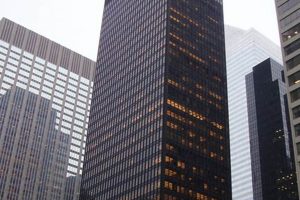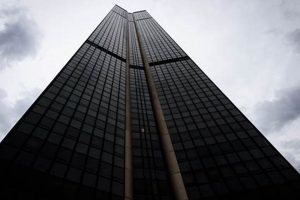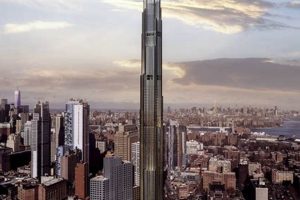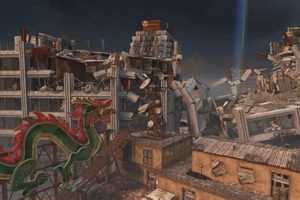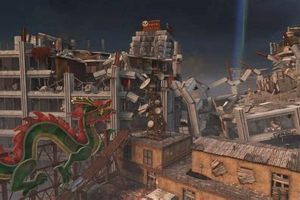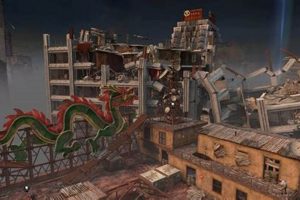When most people think of major cities with towering skyscrapers, they probably think of New York City, Chicago, or Los Angeles. However, Columbus, Ohio, is also home to a number of impressive skyscrapers that contribute to the city’s skyline and economy.
One of the tallest buildings in Columbus is the Rhodes State Office Tower, which stands at 41 stories and 629 feet tall. It is the tallest building in Ohio outside of Cleveland and Cincinnati. Another notable skyscraper in Columbus is the Leveque Tower, which was built in 1927 and is one of the most recognizable buildings in the city. It stands at 30 stories and 473 feet tall and still offers stunning views of the city’s skyline.
Skyscrapers play an important role in the economy of Columbus by providing office space for businesses and housing for residents. They also contribute to the city’s overall aesthetic appeal and make it a more attractive place to live and work.
1. Height
The height of Columbus skyscrapers is one of their most striking features. The Rhodes State Office Tower, the tallest building in Ohio outside of Cleveland and Cincinnati, stands at 629 feet tall. Other notable skyscrapers in Columbus include the Leveque Tower (473 feet), the Huntington Center (470 feet), and the Capitol Square Building (422 feet).
The height of Columbus skyscrapers is important for several reasons. First, it gives them a commanding presence in the city’s skyline. Second, it allows them to accommodate more tenants and generate more revenue. Third, it can be a symbol of the city’s economic power and growth.
There are several challenges associated with building tall skyscrapers. One challenge is the need for a strong foundation. The taller the building, the deeper the foundation must be. Another challenge is the need for a strong structural system. The taller the building, the more wind it will experience. This means that the building must be able to withstand high winds without swaying or collapsing.
Despite the challenges, building tall skyscrapers can have several benefits. One benefit is that it can help to create a more dense and vibrant urban environment. Another benefit is that it can help to reduce traffic congestion by providing more housing and office space in a single location.
2. Architecture
The architecture of Columbus skyscrapers is as diverse as the city itself. From the Art Deco grandeur of the Leveque Tower to the postmodern sleekness of the Huntington Center, Columbus skyscrapers reflect the city’s rich history and its ever-changing skyline.
- Art Deco
The Art Deco style was popular in the 1920s and 1930s, and it is characterized by its geometric forms, bold colors, and stylized ornamentation. The Leveque Tower is one of the best examples of Art Deco architecture in Columbus. Built in 1927, the Leveque Tower is a 30-story skyscraper with a distinctive stepped roofline and intricate metalwork.
- Modern
Modern architecture is characterized by its simplicity, functionality, and use of new materials and technologies. The Capitol Square Building is a good example of modern architecture in Columbus. Built in 2010, the Capitol Square Building is a 42-story skyscraper with a sleek glass facade and a minimalist design.
- Postmodern
Postmodern architecture is a reaction against the simplicity and functionality of modern architecture. Postmodern buildings are often characterized by their eclecticism, their use of historical references, and their playful ornamentation. The Huntington Center is a good example of postmodern architecture in Columbus. Built in 1985, the Huntington Center is a 47-story skyscraper with a granite facade and a postmodern design.
The architecture of Columbus skyscrapers is a reflection of the city’s history, culture, and economy. The city’s skyscrapers are a source of pride for Columbus residents, and they are a major attraction for visitors.
3. Location
The location of Columbus skyscrapers is a key factor in their success. Most of the city’s tallest buildings are located in the downtown area, near the Scioto River. This gives them a commanding presence in the city’s skyline and makes them easily accessible to tenants and visitors.
There are several reasons why the downtown area is such a desirable location for skyscrapers. First, it is the center of the city’s business and financial district. This means that there is a high demand for office space in the area. Second, the downtown area is well-connected to the rest of the city by public transportation. This makes it easy for tenants and visitors to get to and from their buildings.
The location of Columbus skyscrapers also has a significant impact on the city’s economy. The buildings provide office space for businesses and housing for residents. This helps to create a more dense and vibrant urban environment. It also helps to reduce traffic congestion by providing more housing and office space in a single location.
In conclusion, the location of Columbus skyscrapers is a key factor in their success. The buildings are located in the heart of the city’s business and financial district, and they are well-connected to the rest of the city by public transportation. This makes them desirable to tenants and visitors, and it helps to create a more dense and vibrant urban environment.
4. Use
Skyscrapers in Columbus are used for a variety of purposes, including office space, residential units, and retail space. This diversity of use contributes to the city’s vibrant and dynamic economy.
- Office Space
The majority of skyscrapers in Columbus are used for office space. This is because Columbus is a major business and financial center. Many of the city’s largest companies, including Nationwide Insurance and Huntington Bank, have their headquarters in Columbus skyscrapers.
- Residential Units
Skyscrapers are also used for residential units. This is becoming increasingly common as more and more people are choosing to live in urban areas. Columbus skyscrapers offer residents a variety of amenities, including stunning views, fitness centers, and swimming pools.
- Retail Space
Skyscrapers can also be used for retail space. This is often found on the lower floors of skyscrapers. Retail space in skyscrapers can be very valuable, as it is located in a high-tr
affic area. - Mixed-Use
Many skyscrapers in Columbus are mixed-use developments. This means that they contain a mix of uses, such as office space, residential units, and retail space. Mixed-use developments are becoming increasingly popular as they offer a variety of benefits, such as convenience and walkability.
The variety of uses for skyscrapers in Columbus contributes to the city’s vibrant and dynamic economy. Skyscrapers provide space for businesses to operate, residents to live, and shoppers to spend money. This diversity of use makes Columbus a great place to live, work, and play.
5. History
The history of Columbus skyscrapers is closely intertwined with the city’s own development. The first skyscraper in Columbus was the Wyandotte Building, which was built in 1898. The Wyandotte Building was a 12-story building, and it was the tallest building in Columbus at the time. The Wyandotte Building was followed by a number of other skyscrapers, including the Leveque Tower, which was built in 1927 and is still one of the tallest buildings in Columbus today.
- The Early Years
The early skyscrapers in Columbus were built in the late 19th and early 20th centuries. These buildings were typically built in the Beaux-Arts style, and they were designed to be both functional and aesthetically pleasing. Many of these early skyscrapers were built to house businesses and offices, and they helped to create a more vibrant and prosperous downtown area.
- The Mid-20th Century
The mid-20th century saw the construction of a number of modernist skyscrapers in Columbus. These buildings were designed to be more efficient and functional than the earlier skyscrapers, and they often featured large windows and open floor plans. Many of these modernist skyscrapers were built to house government agencies and corporate headquarters, and they helped to create a more modern and cosmopolitan downtown area.
- The Late 20th Century
The late 20th century saw the construction of a number of postmodern skyscrapers in Columbus. These buildings were designed to be more playful and eclectic than the earlier skyscrapers, and they often featured unusual shapes and materials. Many of these postmodern skyscrapers were built to house retail stores and luxury apartments, and they helped to create a more vibrant and diverse downtown area.
- The 21st Century
The 21st century has seen the construction of a number of contemporary skyscrapers in Columbus. These buildings are designed to be sustainable and energy-efficient, and they often feature green roofs and other environmentally friendly features. Many of these contemporary skyscrapers are built to house mixed-use developments, and they help to create a more livable and sustainable downtown area.
The history of Columbus skyscrapers is a reflection of the city’s own growth and development. The skyscrapers in Columbus are a source of pride for the city’s residents, and they are a major attraction for visitors.
6. Economic impact
Skyscrapers have a significant economic impact on Columbus. They provide office space for businesses and housing for residents. This helps to create a more dense and vibrant urban environment. It also helps to reduce traffic congestion by providing more housing and office space in a single location.
One of the most important economic benefits of skyscrapers is that they can help to attract and retain businesses. Businesses are more likely to locate in cities with a strong skyline, as this indicates a healthy and prosperous economy. Skyscrapers can also help to increase property values in the surrounding area. This is because they create a more desirable place to live and work.
In addition to the direct economic benefits, skyscrapers can also have a positive impact on the city’s overall economy. They can help to create jobs in the construction, maintenance, and operation of the buildings. They can also help to stimulate the local economy by attracting businesses and residents to the area.
Overall, skyscrapers have a significant positive economic impact on Columbus. They provide office space for businesses, housing for residents, and help to create a more vibrant and prosperous urban environment.
7. Cultural significance
Skyscrapers are more than just tall buildings; they are also cultural icons. They represent a city’s economic power and prosperity, and they can be a source of pride for residents. Columbus skyscrapers are no exception. They are a major part of the city’s skyline, and they play an important role in the city’s culture and economy.
One of the most important cultural aspects of Columbus skyscrapers is their architectural significance. Many of the city’s skyscrapers are architectural masterpieces, and they are a major tourist attraction. The Leveque Tower, for example, is a beautiful Art Deco building that is one of the most recognizable landmarks in Columbus. The Huntington Center is another notable skyscraper, and it is known for its postmodern design. Skyscrapers in Columbus also have a cultural significance as symbols of the city’s economic power and prosperity. The city’s skyline is a testament to the city’s economic growth and development. Skyscrapers are also a major source of pride for Columbus residents. They are a symbol of the city’s strength and resilience.
In conclusion, Columbus skyscrapers have a significant cultural significance. They are architectural masterpieces, symbols of the city’s economic power and prosperity, and a source of pride for residents. The city’s skyscrapers are a major part of the city’s culture and economy, and they are a major tourist attraction.
FAQs about Columbus Skyscrapers
Here are six frequently asked questions about Columbus skyscrapers, along with their answers:
Question 1: What is the tallest skyscraper in Columbus?
Answer: The Rhodes State Office Tower is the tallest skyscraper in Columbus, standing at 629 feet tall.
Question 2: How many skyscrapers are there in Columbus?
Answer: There are over 50 skyscrapers in Columbus.
Question 3: What is the oldest skyscraper in Columbus?
Answer: The Wyandotte Building is the oldest skyscraper in Columbus, built in 1898.
Question 4: What is the most famous skyscraper in Columbus?
Answer: The Leveque Tower is the most famous skyscraper in Columbus, known for its Art Deco design.
Question 5: What are skyscrapers used for in Columbus?
Answer: Skyscrapers in Columbus are used for a variety of purposes, including office space, residential units, and retail space.
Question 6: What is the economic impact of skyscrapers in Columbus?
Answer: Skyscrapers have a significant economic impact on Columbus by pr
oviding office space for businesses and housing for residents, which helps to create a more dense and vibrant urban environment.
In conclusion, Columbus skyscrapers are a major part of the city’s skyline and economy. They are architectural masterpieces, symbols of the city’s economic power and prosperity, and a source of pride for residents.
Tips for Visiting Columbus Skyscrapers
Columbus skyscrapers are a popular tourist destination, and there are a few things you can do to make your visit more enjoyable.
Tip 1: Do your research.
Before you visit, take some time to learn about the different skyscrapers in Columbus. This will help you decide which ones you want to see and how much time you need to spend at each one.
Tip 2: Purchase a CityPASS.
If you plan on visiting multiple skyscrapers, consider purchasing a CityPASS. This pass gives you access to four of Columbus’s top attractions, including the Top of the Rock Observation Deck and the Empire State Building.
Tip 3: Arrive early.
Skyscrapers are popular tourist destinations, so it’s important to arrive early to avoid long lines. If you’re visiting during peak season, consider purchasing a skip-the-line pass.
Tip 4: Be prepared for security.
Skyscrapers have strict security measures in place, so be prepared to go through a security screening before you enter. You may also be asked to remove your shoes and jacket.
Tip 5: Take your time.
Don’t rush your visit. Take some time to enjoy the views from the observation decks and learn about the history of the skyscrapers.
Tip 6: Bring your camera.
The views from the observation decks are incredible, so be sure to bring your camera to capture the moment.
Tip 7: Wear comfortable shoes.
You’ll be doing a lot of walking, so be sure to wear comfortable shoes.
Tip 8: Stay hydrated.
It can get hot and stuffy inside skyscrapers, so be sure to stay hydrated by bringing a water bottle with you.
By following these tips, you can make your visit to Columbus skyscrapers more enjoyable and memorable.
Summary of key takeaways or benefits:
- By doing your research, you can make the most of your visit and see the skyscrapers that interest you the most.
- Purchasing a CityPASS can save you money if you plan on visiting multiple skyscrapers.
- Arriving early can help you avoid long lines.
- Being prepared for security can help you get through the screening process quickly and easily.
- Taking your time can help you enjoy the views and learn about the history of the skyscrapers.
- Bringing your camera can help you capture the incredible views from the observation decks.
- Wearing comfortable shoes can help you avoid foot pain.
- Staying hydrated can help you stay cool and comfortable.
Conclusion
Columbus skyscrapers are a major part of the city’s skyline, economy, and culture. They provide office space for businesses, housing for residents, and help to create a more vibrant and prosperous urban environment. Skyscrapers in Columbus are also architectural masterpieces and symbols of the city’s economic power and prosperity.
As Columbus continues to grow and develop, its skyline will continue to change. New skyscrapers will be built, and old skyscrapers will be renovated. However, one thing is for sure: Columbus skyscrapers will continue to be a major part of the city’s identity.
Columbus skyscrapers are a testament to the city’s economic power, prosperity, and cultural significance. They are a source of pride for residents and a major attraction for visitors. As Columbus continues to grow and develop, its skyline will continue to change, but Columbus skyscrapers will always be a major part of the city’s identity.


